
- Author: Mark Bolda
Since we have had our first field closure in strawberry as of last night, it is important for us all to review how the USDA regulatory process unfolds for growers here.
Field closure is expensive and to be avoided. For readers who are not growers or familiar with commercial strawberry production, consider that the average weekly take out of a field can be 400 boxes per acre that we will conservatively price at 8 dollars a box back to the grower. So the weekly cost of LBAM closure to a fifty acre field is 160,000 dollars. Personally speaking, this enormous penalty is totally out of proportion with the infraction of having a quarantined pest in one’s field, but it is not my decision to make.
Cooler Inspection: USDA inspectors are to visit area coolers at regular intervals, my understanding is that because of the reduced budget for the program they will be checking in at each local facility once a month. This may change however depending on the vagaries of Federal budgets and politics. Once at the cooler, inspectors take a subsample from a load of fruit from each production field for that day. The inspectors are VERY thorough, the field closure from last night came from a larva tucked under the calyx. Unfortunately, such a larva often cannot be identified right away and so a hold is put on fruit coming out of that field. In plain English, that means the field is closed and you can no longer harvest and send fruit out of that field.
Field Inspection: Once a field has been identified as possibly infested with light brown apple moth, the next step is for inspectors to do an inspection of the field itself. I have seen field inspection, and it does not leave one leaf unturned. For somebody with experience, leaf rolls are easy to see, and inspectors walk with up to six people abreast, one person per row. Since this is their job, day in and day out, they are really good at it and if you have a leafroller, it will be found.
Treatment of Infested Fields: If no leafrollers are discovered during the field inspection, the field is opened back up. If a leafroller is discovered and furthermore found to be positive for LBAM, the grower is mandated to make an application. He or she chooses from a list of allowed materials, and fortunately this year, according to program director Rick McKay, surfactants and adjuvants are allowed and highly recommended. All parts of the application are observed by inspectors from loading, mixing and the actual spray. Nothing says that the grower can't be making applications before and after this regulated application, but they need to see the one they mandate. Then, depending on the pesticide used, inspectors return after a specified number of days to re-inspect the field. If no more leafrollers are found, the field is opened back up. If a leafroller is found, the field remains closed and the application procedure is repeated. Experience from last year says more often than not it takes more than one spray to re-open a field. In some cases, especially in organic fields, which have a much narrower selection of effective materials, it can take more than a month to re-open.
Discussion: It is imperative that growers pay attention to leafrollers in their fields. Yes, they are around, because I have been getting phone calls about this all week long now. Conventional growers have a wide range of materials at their disposal, organic growers less. It is not a bad thing yet to be putting out the pheromone mating disruption twist ties, since we are probably looking at a flight of adult moths in late June, with a subsequent larval infestation in July and August again. In light of the devastating costs of field closure, it might not be too much to have crews go through the fields regularly and be removing rolls.
- Author: Mark Bolda
This is a revision from the previous post:
A couple of samples handled by this office from strawberry over the past two weeks have turned out to be a leafroller species which might not be light brown apple moth. Probably the reason people have been asking about these is the general concern about having leafrollers in one’s production field at all. This is understandable, considering the current regulatory environment which mandates closure of at least part of a field on discovery of one species of leafroller; the light brown apple moth. Fields can also be temporarily shut down as regulators work on distinguishing leafrollers from one another in order to get a positive light brown apple moth identification.
The following short description will be about garden tortrix in strawberry.
This very important for those making a definitive identification in the field. While the UC IPM guidelines refer to garden tortrix as having a "spot on the back of the head" this spot is actually a darkened prothoracic shield behind the head on not on it (see fourth picture below). I would very much like to get a definitive sample from our area of garden tortrix for a clear picture for this blog, so will ask my readership to bring any suspect samples. It would be very helpful.
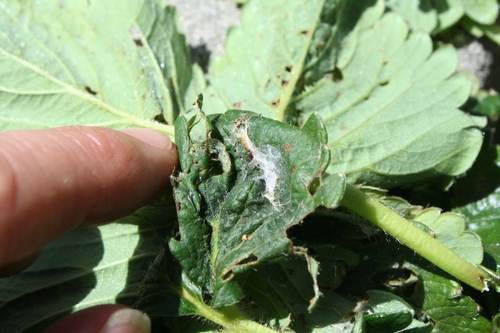
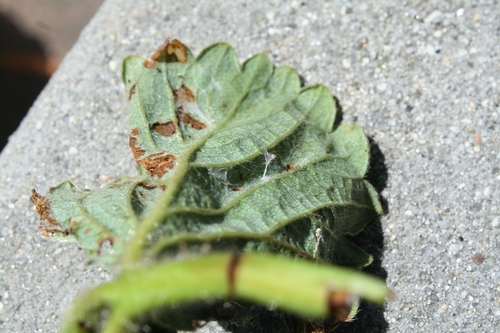
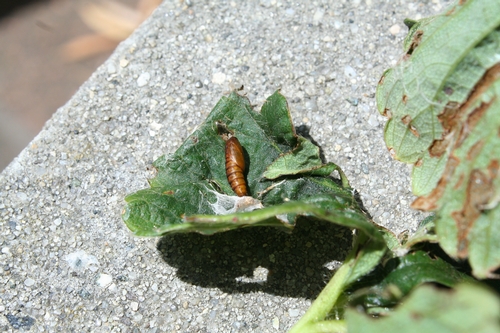
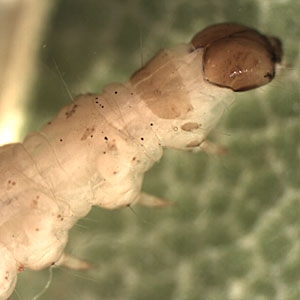
- Author: Mark Bolda
Blackberry growers in the Pajaro Valley should be aware that there are substantial numbers of light brown apple moth (LBAM) larvae active in many fields right now. The photos below outline what this pest looks like and what it is doing right now in our blackberry fields.
In the photographed field, there were on the order of 7-9 leafrolls per two feet of hedge in the heaviest infested areas and in excess of 80% of the leafrollers sampled in the photographed field were identified as having a very high likelihood of being LBAM. This is very concerning, since under the current quarantine enforced by the USDA, the presence of any leafroller in a field can be cause for significant delay of harvest much less outright field closure if an LBAM is found.
While clearly not the level of devastating 100% loss of harvest caused by field closure for a positive LBAM find, LBAM itself is also capable of causing some damage. As one can see from the photos below, damage ranges from incidental feeding on flowers resulting in blemished (thus unmarketable) fruit to heavier feeding causing abortion of entire laterals and the subsequent loss of fruiting potential there. In the field photographed below there was damage of some sort to one of every sixteen fruiting laterals.
Anecdotally, it appears that growers who kept up with changing out pheromone based twist ties every four to six months have very low populations of LBAM suspect leafrolls, while those who allowed pheromone coverage to expire before putting up a fresh set are tending to have heavier, in some cases very heavy, larval infestations. If one is not going to be using pheromone based twist ties through the entire year, it is at least a good idea to put out a few pheromone traps to find out when adult males are starting to fly and looking to mate so as to better target use of mating disruption techniques.
As it seems many of the larvae being discovered currently are in the fourth to late instar stage (½ to ¾ inches in length), applications of Bacillus thuriengiensis formulations will not prove to be very effective. Better materials are the spinosyns, one of which (Entrust) is registered for use in organic fields, and bifenthrin (hard on beneficials though). Addition of a good surfactant is always a good idea to break spray water surface tension to facilitate movement of material into even the tightliest wound leafroll.
There are several insecticides mentioned for control of light brown apple moth in this article. Before using any insecticides, check with your local Agricultural Commissioner's Office and consult product labels for current status of product registration, restrictions, and use information.
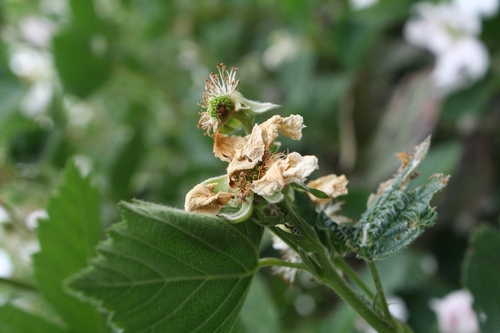
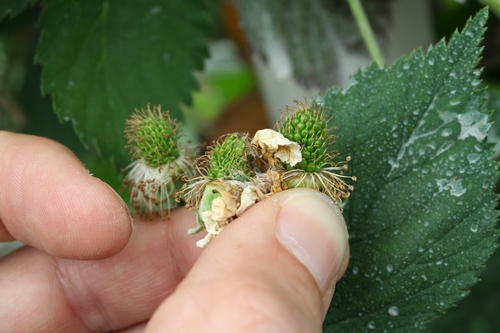
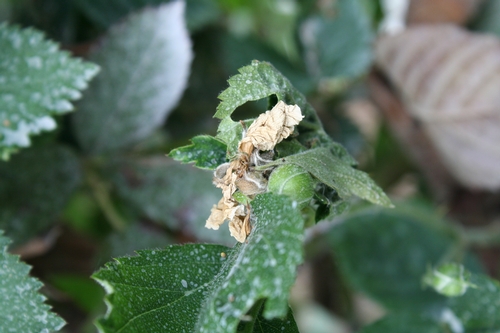
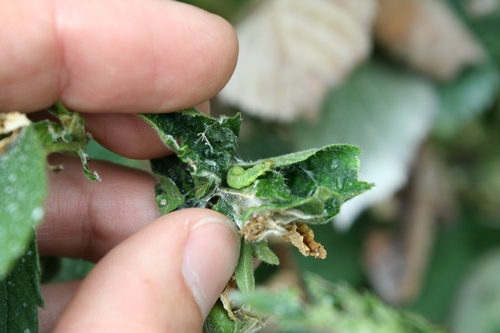
- Author: Mark Bolda
Mark Bolda
Hillary Thomas
The use of pheromone based twist ties has found significant success in reducing the incidence of light brown apple moth mating in caneberries grown on the Central Coast of California. With the recent advent of light brown apple moth infestation in area strawberries, especially those in organic production, there has been a groundswell of interest on testing the same technology there.
The following is a brief description of a trial mounted on the part of the authors in testing whether the use of pheromone based twist ties could be useful and successfully applied in strawberries. On June 15, twist ties wound around chopsticks were distributed evenly (every other strawberry row with 16 to 18 feet between each stick) across 8 acres of organic strawberry at the rate of 300 per acre (higher end recommended label rate), with another 8 acres left alone as an untreated check. This was replicated 4 times in various fields around Watsonville.
A matrix of twelve traps using pheromone lures was placed in each 8-acre field to test the ability of the pheromone based twist ties to prevent males from finding females emitting the same pheromone. The idea is that if the males are unable to locate the pheromone lure in the trap, they will not be able to locate females and subsequently not be able to mate, resulting in population reduction.
Traps were checked yesterday, June 29. Out of the 48 total traps placed over the four treated plots, only a single male moth was captured, while the traps in the untreated check contained two moth males on average.
Trap Captures of Light Brown Apple Moth Males, June 29, 2010
Totals are from 12 traps in each plot
with pheromone without pheromone
Field 1 1 23
Field 2 0 27
Field 3 0 23
Field 4 0 42
The results suggest the twist ties may be useful as part of an integrated strategy to reduce light brown apple moth populations in fields, especially for organic growers who have limited available management tools.


- Author: Mark Bolda
Mark Bolda
UC Cooperative Extension
Hillary Thomas
Post Doctoral Scholar, UC Davis
Light brown apple moth (LBAM) is a species of leafroller that was first detected in California in 2007 and is currently present on the Central Coast. It is a class A pest that has been subject to quarantine. This has resulted in strict regulation of its host crops, mandating zero tolerance for larvae in fields or on harvested fruit, and occasioned the financially devastating closure of several fields of caneberries in 2009.
For 2010, Central Coast caneberry growers have a variety of management methods available to them which they can deploy in their efforts to prevent LBAM from being detected in their fields. These methods are (1) mating disruption, (2) insecticide use and (3) cultural management. The following is summary for growers of how best to integrate these three methods to achieve the greatest result.
Mating Disruption: Field trials conducted by UC Davis in the fall of 2009 suggest that pheromone based mating disruption is a promising tool for managing light brown apple moth in caneberries. While these trials tested three possible pheromone application technologies, currently only the twist ties, also known as pheromone rope dispensers, are available.
Mating disruption with pheromone based twist ties is very attractive to use as a management tool, because of low toxicity, compatibility with biological control, high specificity to the target pest, reduced risk of resistance and ease of use. However, the use of twist ties should be supplemented at this time with insecticide sprays and cultural controls because it has not yet been determined whether there is a stand-alone twist tie application rate that will result in zero detection of light brown apple moth in fields, as currently mandated by state and Federal regulatory agencies. Additionally, management of similar looking leafroller species is useful, to reduce the probability of economic loss due to delays for leafroller identification during cooler and field inspections. Twist tie applications for light brown apple moth are target specific and will not be useful for managing other lepidopterous pests such as orange tortrix.
Mating disruption works best when applied over large continuous areas. Twist ties should be placed all across the production field. Non-production fields should be included if they are mixed in production fields so a contiguous area is formed. If possible, it is suggested to place twist ties as far out as the edges of the field or slightly farther where possible, to reduce the probability of a mated female moth flying in from external sources.
The minimum recommended label rate of 200 twist ties per acre appears to reduce LBAM pheromone trap captures to very low numbers, but does not result in zero detection of moths within a field. Therefore, where economically possible it is recommended that the twist ties be applied at a rate higher than this, up to the higher end label-recommended rate of 300 twist ties per acre. For severe infestations, more than 300 twist ties per acre may be warranted, so long as it remains below the maximum threshold allowed on the label. Twist ties should be attached to the upper trellis wire (see first picture below), and it is recommended that they be wrapped doubly around the wire if operations such as pruning and cane adjustment will be taking place for the duration of their use, which typically will be six months. If in-field monitoring is being conducted and there is a rise in adult moth finds 3-6 months after initial twist tie application, this could be an indication of reduced pheromone release by the dispensers. However, fluctuations in the moth population over time may also account for such a change, with flight peaks anticipated in the spring around April, June and a fall population peak between October and November. Following the early spring application, if desired, twist ties may be applied again after harvest to target the fall flight peak.
Insecticides: Since 2010 is the first year that mating disruption is being put into practice for light brown apple moth, and its efficacy for reducing light brown apple moth populations is not yet fully known, the use of twist ties should be supplemented with the use of insecticides to reduce the probability of an in-field light brown apple moth find. This also has the added benefit of targeting similar looking leafroller species, such as orange tortrix.
Since caneberry hedgerows are smaller and larval leafroller populations lower in the early part of year it is recommended that a program of spraying begin in late February to mid-March. As there is a wide variety of good leafroller pesticides available, growers should seek materials that have a lower impact on beneficials and the surrounding environment. Materials should also be rotated to mitigate the potential for resistance to a single pesticide.
Following the initial early season spray, it is important that growers continue to monitor the field for leafrollers. Growers should look for leaf surfaces that are webbed or rolled together, especially those of newly extending laterals Additionally, look for signs in newly extending laterals for webbing, frass, leaf damage, and the presence of larvae.
(for examples of LBAM and other leafroller infestation see photos below as well as the link: http://www.ipm.ucdavis.edu/EXOTIC/lightbrownapplemoth.html).
Another good way to look for leafrollers is to agitate the hedgerow, either by beating or shaking the plants, and collect the fallen material into a bucket or wide, flat container. Carefully sift through this material to detect larvae (early larval instars can be quite small). Concentrate monitoring activities in suspected or previously infested areas.
Any sign of leafroller activity should be a signal to act to protect the crop. It should be emphasized here that the economic threshold for leafrollers during this period of regulation is zero, and subsequently the threshold for spraying is much lower than one would deploy in an integrated pest management program.
Cultural Controls: Because of the zero tolerance mandated for light brown apple moth infestation in fields, it is recommended that growers impress upon harvest crews the importance of removing suspect rolled leaves, larvae and webbed fruit. Considering that crews are passing over every foot of hedgerow at least three times a week during harvest, they can be very effective in reducing LBAM and other leafroller numbers. An incentive program can be implemented to encourage participation with such a campaign of larval removal.
Proper sanitation practices during the dormant season will be an essential part of light brown apple moth management. Larvae will overwinter in leaf trash and surrounding weeds. Keep weeds to a minimum and move fallen leaves to the middle of rows where they can be disked into the soil.
There are pesticides mentioned for management of leafrollers in this article. Before using any of these products, check with your local Agricultural Commissioner's Office and consult product labels for current status of product registration, restrictions, and use information.






